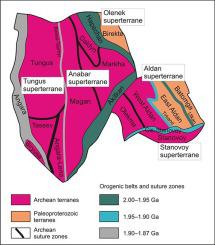当前位置:
X-MOL 学术
›
Precambrian. Res.
›
论文详情
Our official English website, www.x-mol.net, welcomes your
feedback! (Note: you will need to create a separate account there.)
Assembly of the Siberian Craton: Constraints from Paleoproterozoic Granitoids
Precambrian Research ( IF 3.2 ) Pub Date : 2020-09-01 , DOI: 10.1016/j.precamres.2020.105869 T.V. Donskaya
Precambrian Research ( IF 3.2 ) Pub Date : 2020-09-01 , DOI: 10.1016/j.precamres.2020.105869 T.V. Donskaya

|
Abstract The paper presents a synthesis of geochronological, geochemical, and isotopic data on Paleoproterozoic granitoids in the Siberian craton and, in some cases, on volcanics related to these granitoids. Different evolution stages of the craton, including its assembly, are recorded in several major events in the history of Paleoproterozoic granitic magmatism. They are 2.52-2.40 Ga and 2.15–2.04 Ga granitoids of different tectonic settings; 2.06–2.00 Ga subduction-related granitoids; 2.00–1.87 Ga collisional granitoids; 1.88–1.84 postcollisional granitoids, and 1.76–1.71 Ga within-plate (anorogenic) varieties. Granitoids with ages of 2.5–2.4 Ga and 2.15–2.04 Ga are distributed locally in separate blocks and terranes which later entered the craton structure. These rocks are of different types and represent different tectonic settings of the respective blocks and terranes, i.e., the Siberian craton did not exist yet as a single unit at that time. The 2.06–2.00 Ga subduction-related granitoids and volcanics are found in the southern and southeastern craton parts. Magmatism of that time interval probably was associated with subduction beneath the Archean Olekma-Aldan and Anabar continental microplates and with the formation of their active margins. Granitoids of the 2.00–1.87 Ga age interval represent a collisional stage of the craton evolution. Collisional granitoids that intruded between 2.00 and 1.95 Ga record the first large-scale stage of craton assembly with collisions of terranes that had built the core of the Anabar, Aldan, and Olenek superterranes. The intrusions of 1.95–1.90 Ga granitoids mark the consolidation of the southeastern craton part. Collisional granitoids with the 1.90–1.87 Ga ages, which are especially abundant in the south and southwest of the craton but almost lack from the north, led to general assembly of the craton. The granitoid and volcanic magmatic activity of 1.88–1.84 Ga in the craton south produced the South Siberian postcollisional magmatic belt that had completed the assembly of the craton which, in its turn, may have been part of the Paleoproterozoic supercontinent of Columbia. Granitic intrusions at 1.76–1.71 Ga are limited to the southwestern and southeastern craton parts and correspond to a setting of continental extension which never led to the breakup of the craton.
中文翻译:

西伯利亚克拉通的组装:来自古元古代花岗岩的约束
摘要 本文综合介绍了西伯利亚克拉通中古元古代花岗岩的年代学、地球化学和同位素数据,以及在某些情况下与这些花岗岩有关的火山岩。克拉通的不同演化阶段,包括它的组装,在古元古代花岗岩岩浆作用历史上的几个重大事件中都有记载。它们是不同构造环境的 2.52-2.40 Ga 和 2.15-2.04 Ga 花岗岩;2.06-2.00 Ga 俯冲相关花岗岩;2.00-1.87 Ga 碰撞花岗岩;1.88-1.84 碰撞后花岗岩和 1.76-1.71 Ga 板内(非造山)品种。年龄为 2.5-2.4 Ga 和 2.15-2.04 Ga 的花岗岩局部分布在单独的块体和地体中,后来进入克拉通构造。这些岩石的类型不同,代表了各个块体和地体的不同构造环境,即当时西伯利亚克拉通还没有作为一个整体存在。在克拉通南部和东南部发现了与 2.06-2.00 Ga 俯冲相关的花岗岩和火山岩。那个时间段的岩浆活动可能与太古代奥列克马-阿尔丹和阿纳巴尔大陆微板块下的俯冲及其活动边缘的形成有关。2.00-1.87 Ga 年龄区间的花岗岩代表克拉通演化的碰撞阶段。在 2.00 到 1.95 Ga 之间侵入的碰撞花岗岩记录了克拉通组装的第一个大规模阶段,其中地体碰撞形成了阿纳巴尔、阿尔丹和奥列尼克超级地体的核心。1.95-1 的入侵。90 Ga 花岗岩标志着东南克拉通部分的固结。1.90-1.87 Ga 时代的碰撞花岗岩,在克拉通南部和西南部特别丰富,而北部几乎没有,导致了克拉通的总体组装。克拉通南部 1.88-1.84 Ga 的花岗岩和火山岩浆活动产生了南西伯利亚碰撞后岩浆带,该岩浆带完成了克拉通的组装,而后者可能是哥伦比亚古元古代超大陆的一部分。1.76-1.71 Ga 的花岗岩侵入仅限于克拉通西南部和东南部部分,对应于从未导致克拉通解体的大陆伸展环境。在克拉通南部和西南部特别丰富,而北部几乎缺乏,导致了克拉通的大会。克拉通南部 1.88-1.84 Ga 的花岗岩和火山岩浆活动产生了南西伯利亚碰撞后岩浆带,该岩浆带完成了克拉通的组装,而后者可能是哥伦比亚古元古代超大陆的一部分。1.76-1.71 Ga 的花岗岩侵入仅限于克拉通西南部和东南部部分,对应于从未导致克拉通解体的大陆伸展环境。在克拉通南部和西南部特别丰富,而北部几乎缺乏,导致了克拉通的大会。克拉通南部 1.88-1.84 Ga 的花岗岩和火山岩浆活动产生了南西伯利亚碰撞后岩浆带,该岩浆带完成了克拉通的组装,而后者可能是哥伦比亚古元古代超大陆的一部分。1.76-1.71 Ga 的花岗岩侵入仅限于克拉通西南部和东南部部分,对应于从未导致克拉通解体的大陆伸展环境。克拉通南部的 84 Ga 产生了南西伯利亚碰撞后岩浆带,该岩浆带完成了克拉通的组装,而后者可能是哥伦比亚古元古代超大陆的一部分。1.76-1.71 Ga 的花岗岩侵入仅限于克拉通西南部和东南部部分,对应于从未导致克拉通解体的大陆伸展环境。克拉通南部的 84 Ga 产生了南西伯利亚碰撞后岩浆带,该岩浆带完成了克拉通的组装,而后者可能是哥伦比亚古元古代超大陆的一部分。1.76-1.71 Ga 的花岗岩侵入仅限于克拉通西南部和东南部部分,对应于从未导致克拉通解体的大陆伸展环境。
更新日期:2020-09-01
中文翻译:

西伯利亚克拉通的组装:来自古元古代花岗岩的约束
摘要 本文综合介绍了西伯利亚克拉通中古元古代花岗岩的年代学、地球化学和同位素数据,以及在某些情况下与这些花岗岩有关的火山岩。克拉通的不同演化阶段,包括它的组装,在古元古代花岗岩岩浆作用历史上的几个重大事件中都有记载。它们是不同构造环境的 2.52-2.40 Ga 和 2.15-2.04 Ga 花岗岩;2.06-2.00 Ga 俯冲相关花岗岩;2.00-1.87 Ga 碰撞花岗岩;1.88-1.84 碰撞后花岗岩和 1.76-1.71 Ga 板内(非造山)品种。年龄为 2.5-2.4 Ga 和 2.15-2.04 Ga 的花岗岩局部分布在单独的块体和地体中,后来进入克拉通构造。这些岩石的类型不同,代表了各个块体和地体的不同构造环境,即当时西伯利亚克拉通还没有作为一个整体存在。在克拉通南部和东南部发现了与 2.06-2.00 Ga 俯冲相关的花岗岩和火山岩。那个时间段的岩浆活动可能与太古代奥列克马-阿尔丹和阿纳巴尔大陆微板块下的俯冲及其活动边缘的形成有关。2.00-1.87 Ga 年龄区间的花岗岩代表克拉通演化的碰撞阶段。在 2.00 到 1.95 Ga 之间侵入的碰撞花岗岩记录了克拉通组装的第一个大规模阶段,其中地体碰撞形成了阿纳巴尔、阿尔丹和奥列尼克超级地体的核心。1.95-1 的入侵。90 Ga 花岗岩标志着东南克拉通部分的固结。1.90-1.87 Ga 时代的碰撞花岗岩,在克拉通南部和西南部特别丰富,而北部几乎没有,导致了克拉通的总体组装。克拉通南部 1.88-1.84 Ga 的花岗岩和火山岩浆活动产生了南西伯利亚碰撞后岩浆带,该岩浆带完成了克拉通的组装,而后者可能是哥伦比亚古元古代超大陆的一部分。1.76-1.71 Ga 的花岗岩侵入仅限于克拉通西南部和东南部部分,对应于从未导致克拉通解体的大陆伸展环境。在克拉通南部和西南部特别丰富,而北部几乎缺乏,导致了克拉通的大会。克拉通南部 1.88-1.84 Ga 的花岗岩和火山岩浆活动产生了南西伯利亚碰撞后岩浆带,该岩浆带完成了克拉通的组装,而后者可能是哥伦比亚古元古代超大陆的一部分。1.76-1.71 Ga 的花岗岩侵入仅限于克拉通西南部和东南部部分,对应于从未导致克拉通解体的大陆伸展环境。在克拉通南部和西南部特别丰富,而北部几乎缺乏,导致了克拉通的大会。克拉通南部 1.88-1.84 Ga 的花岗岩和火山岩浆活动产生了南西伯利亚碰撞后岩浆带,该岩浆带完成了克拉通的组装,而后者可能是哥伦比亚古元古代超大陆的一部分。1.76-1.71 Ga 的花岗岩侵入仅限于克拉通西南部和东南部部分,对应于从未导致克拉通解体的大陆伸展环境。克拉通南部的 84 Ga 产生了南西伯利亚碰撞后岩浆带,该岩浆带完成了克拉通的组装,而后者可能是哥伦比亚古元古代超大陆的一部分。1.76-1.71 Ga 的花岗岩侵入仅限于克拉通西南部和东南部部分,对应于从未导致克拉通解体的大陆伸展环境。克拉通南部的 84 Ga 产生了南西伯利亚碰撞后岩浆带,该岩浆带完成了克拉通的组装,而后者可能是哥伦比亚古元古代超大陆的一部分。1.76-1.71 Ga 的花岗岩侵入仅限于克拉通西南部和东南部部分,对应于从未导致克拉通解体的大陆伸展环境。











































 京公网安备 11010802027423号
京公网安备 11010802027423号